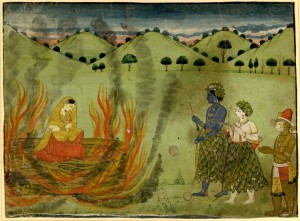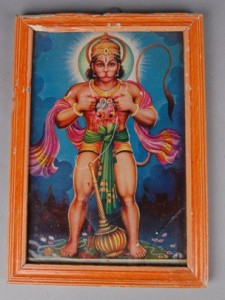by Maeve Herrick
The treatment and portrayal of Sita throughout the Ramayana is troubling. Sita is devoted to Rama, but at the end of the epic, Rama mistreats Sita by doubting her chastity and exiling her (Buck 390-394). The end of the Ramayana is especially difficult for readers because Rama’s treatment of Sita is overwhelmingly understood as unjust and cruel (Kishwar 1997, 24). Contemporary Hindu women often understand Sita’s strength and pride in reaction to her mistreatment as a source of strength and power. Images of Sita in contemporary Hindu society show her to be both the ideal woman and a source of empowerment.
A review of the passages in William Buck’s translation of the Ramayana in which Sita is mistreated is necessary to contextualize Sita as a source of empowerment. After being rescued from Ravana, Sita must endure a trial by fire to ensure Rama that she is pure despite having been captured and imprisoned by Ravana (Buck 363-366). During the trial, Agni the Fire Lord and Indra the Rain Lord protect Sita from the flames (Buck 364-365). Rama understands Sita to be pure because Fire was the witness (Buck 365). Later, Rama hears that there have been whispers within his kingdom concerning the chastity of Sita (Buck 391). Although Sita is pregnant, Rama proceeds to banish her in order to fulfill his dharma as king (Buck 390-394). At the end of the Ramayana Rama throws a party where his sons recite the epic which has been taught to them by Valmiki (Buck 409). When they finish, Rama realizes who they are and decides that he wants Sita to come back to him (Buck 411-415). Sita proves her innocence to Rama by being swallowed by the earth, her mother (Buck 415). She says, “‘Mother Earth, if I have been faithful to Rama take me home, hide me!’” (Buck 415). In a final act of defiance, Sita leaves Rama as he left her. Rama’s mistreatment of Sita and Sita’s strength and defiance has led to modern, empowering images of Sita.
The image of Sita in the Ramayana is potentially problematic because Sita is constructed as infallible as a result of her undying loyalty to Rama, despite his poor treatment of her (Kishwar 1997, 23). Madhu Kishwar shows that while some feminists view Sita as a negative image for women, her character cannot be changed and it is necessary to be tolerant of the ideals that women have adopted for themselves (Kishwar 2004, 3). Sita’s actions throughout the Ramayana have positioned her as the ideal wife within Hindu society because she is the character who best followers her dharma (Kishwar 1997, 22). While Rama is revered in Hindu society, he is understood to be a poor husband (Kishwar 1997, 29) This positioning of Sita against Rama helps Hindu wives to emanate Sita and assert power over their husbands within a patriarchal society because no husband would leave or mistreat a wife who is as flawless in behavior as Sita; to do so would be to act like Rama (Kishwar 1997, 28-31, 2004, 3-5). Emanating the image of Sita as a flawless woman who follows her dharma in the face of adversity empowers contemporary Hindu women.
There have been numerous adaptations of the Ramayana (Hess). People, especially women have written literature which describes Sita’s side of the story. These discourses range from modern poems, stories, and plays, to folk songs, and sixteenth century poems (Hess 16-23). The poet Shankaradeva, who wrote around the year 1600, conveys Sita as scolding Rama for his mistreatment of her before returning to the earth (Hess 21). Another sixteenth century female writer, Chandrabuti, told the Ramayana from a female perspective (Luthra 138-141). Women also use folk songs about Sita to give voice to their own feelings and emotions (Luthra 138-144). Sita is understood as an orphan, a concept that many Hindu women can relate to as they must move between the home of their family and the home of their husband’s family (Luthra 140). Women also relate to Sita’s suffering and are not afraid to call Rama bad names in their songs (Luthra 140-141). Women also imagine Rama to have banished Sita as a result of jealousy (Luthra 141). More recent female writers connect Sita’s suffering to woman’s suffering in patriarchal societies (Luthra 147-148, 153). Sita’s protest of the trial by fire may be understood as a protest of the male-dominant society (Luthra 153-154). These understandings of Sita focus on the parts of the Ramayana which speak to women and how the patriarchal system has marginalized them (Luthra 153). By connecting to Sita’s suffering and addressing it through song and writing women protest the system which subjugates them, and are then able to become empowered. While the patriarchal view dominates in society, many contemporary women are “rejecting the Sita of patriarchy” (Hess 28). The reinterpretation of the patriarchal images of Sita, placing her as a source of strength and courage is empowering to contemporary Hindu women.
The image to the right is a deviation from a similar image of Hanuman depicted in the Ramayana. In the epic, Hanuman is wholly and solely a devotee of Rama, and he exhibits this through numerous acts of valor which save Rama’s life and help Rama to kill Ravana and rescue Sita (Buck 211-277, 305-319, 361-388, 405-414, 425-427, 431). There is a striking image of Hanuman where he is opening his chest to reveal inscriptions of Rama covering his bones, indicating his deep devotion to the deity, “Then with his sharp fingernails Hanuman tore open his breast and pulled back the flesh. And see! There was written again and again on every bone, in fine little letters – Rama Rama Rama Rama….” (Buck 426, 431). The image is a reflection of the image from the Ramayana, but it has been adapted to include Sita. This adaptation is significant because it places Sita as the equal of Rama in Hanuman’s heart. Darsan is the way through which Hindus worship; they experience the divine through gazing at images of gods (Eck 3). Sita and Rama are often depicted together, and their images are the media through which Hindus may experience the divine (Kishwar 1997, 24-25, Eck 3). Sita is thus depicted as powerful and worthy of devotion and may appropriately give darsan. The image above shows that Sita is equal to Ram in her ability to give and receive darsan, which is empowering to women.
Images of Sita may also be drawn upon in order to motivate men to contribute to the empowerment of women. The Shetkari Sangathana leader, Sharad Joshi, fought for gender justice among farmers in Maharashtra, and in doing so equated the wives of farmers to Sita (Kishwar 2004, 3-6). Joshi showed that the Sitas of Maharashtra worked very hard and that the husbands of the area were being as undeserving as Rama (Kishwar 2004, 4). These images of Sita helped to motivate the husbands to transfer land to their wives as payment of debts to Sita, and to the Sitas (Kishwar 2004, 3-6). The men recognized that Rama was not a good husband to Sita, so they were motivated to act differently towards their wives. The image of Sita as a good, hardworking wife is associated with the modern women of Maharashtra in order to motivate men to justice. Thus, the image of Sita as a good wife and a strong woman who is embodied by modern women may be empowering.
The mistreatment of Sita in the Ramayana is used by women to assert control over their husbands as they emanate the ideal woman and wife (Kishwar 1997, 30-31). Images of Sita in literature are also adapted to highlight her strength despite the hardships she is forced to endure (Hess 16-28, Luthra 138-154). The literal image of Sita seated beside Rama inside Hanuman’s chest shows that she is Rama’s equal. The image of Sita in Hindu society may also be used to motivate men to aid in the empowerment of contemporary Sitas (Kishwar 2004, 3-5). These images of Sita in modern Hindu society show her to be both the ideal woman and a source of empowerment.
Works Cited:
Buck, William. Ramayana. Berkeley and Los Angeles: University of California Press. 1976.
Eck, Diana L. Darsan: Seeing the Divine Image in India. Columbia University Press. 1998.
Framed paper print of Hanuman standing, opening his chest to reveal Rama and Sita. Mace resting on the floor before him. Digital image.Collection Online. The British Museum, Web. http://www.britishmuseum.org/research/collection_online/ collectionobject_details.aspx?searchText=sita&from=ad&fromDate=1950&ILINK|34484,|assetId=1215690& objectId=550553&partId=1
Hess, Linda. “Rejecting Sita: Indian Responses to the Ideal Man’s Cruel Treatment of His Ideal Wife,” Journal of the American Academy of Religion, Vol 67. No. 1 (Mar. 1999): 1-32.
Kishwar, Madhu. “The Power of Mother Sita in Modern India.” Hinduism Today, (2004): 1-7. ProQuest.
Kishwar, Madhu. “Yes to Sita, No to Ram! The Continuing Popularity of Sita in India.” Manushi, no 98 (1997):20-31
Luthra, Rashmi. “Clearing Sacred Ground: Women Centered Interpretations of the Indian Epics.” Feminist Formation, 26:2 (2014): 135-161. Project Muse.
Painting from the Ramayana of Sita’s trial by fire watched by Rama, Lakṣmaṇa, and Hanuman. Painted on paper. Digital image. Collection Online. The British Museum, Web. http://www.britishmuseum.org/research/collection_online/collection_object_details.aspx?objectId=233576&partId=1&searchText=sita&page=1


